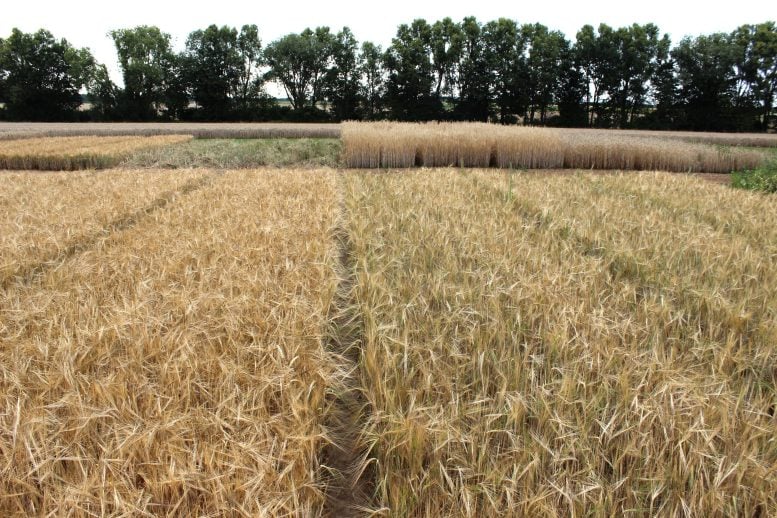In a 23-year study at the University of Bonn, researchers found that organically grown barley genetically adapted to its environment and became more genetically diverse and robust compared to conventionally grown barley. The study emphasizes the need to develop plant varieties specifically for organic farming to exploit these adaptive advantages. Photo credit: SciTechDaily.com
A research project at the University of Bonn shows differences in plant growth between organic and conventional cultivation methods.
A long-term study by the University of Bonn has shown that plants can genetically adapt to the specific conditions of organic farming. In the study, researchers grew barley in two adjacent fields, using conventional farming techniques in one and organic practices in the other.
Over the course of more than 20 years, the organic barley was enriched with specific genetic material that differed from the reference crop. The results show, among other things, how important variety cultivation is, especially for organic farming. The results have now been published in the specialist journal Agronomy for sustainable development.
At the end of the 1990s, Prof. Dr. Jens Léon at the University of Bonn carried out an experiment that he knew would run over a long period of time. His research group wanted to investigate the effects of agricultural conditions on the genome of plants. To do this, they conducted a complex long-term study over a period of 23 years at the Institute for Crop Science and Resource Conservation (INRES). “We first crossed high-yielding barley with a wild variety to increase genetic variation,” says Léon. “We then planted these populations in two neighboring fields so that the barley grew on the same soil and under the same climatic conditions.”

The image above shows the conventional population on the left and the organic barley on the right: only experts can see the differences with the naked eye. However, large differences can be detected using molecular genetics. Photo credit: AG Prof. Léon/University of Bonn
The only difference was the cultivation method. Conventional farming was practiced on one of the fields, in which the researchers used pesticides to control pests, chemicals to kill weeds and mineral fertilizers to ensure a good supply of nutrients. In the other area, the researchers pursued an ecologically more sensible approach: avoiding pesticides, controlling weeds using mechanical methods and fertilizing the soil with farmyard manure
A portion of the grains was kept back each autumn to be sown in the fields the following spring – with the organic grains being used in the organic field and the barley grown under conventional conditions in the control field. “However, we did not select the grains based on any particular characteristics, but simply selected a small portion of the harvest at random,” emphasizes Léon’s colleague Dr. Michael Schneider.
Analysis of genome evolution in time lapse
In addition, the researchers analyzed the genomes of conventionally and organically grown plants every year. Each individual gene can exist in different forms, called alleles. For example, the human gene responsible for eye color exists in the “brown” and “blue” alleles. The frequency with which certain alleles appear in a population can change across generations. One factor that plays a role is environmental conditions: alleles that ensure that plants thrive in their current environment tend to become more common.
The researchers identified two interesting trends in their genetic tests: In the first twelve years, the allele frequency in barley changed in the same way in both fields. “Our interpretation of this finding is that the very different populations created by crossing with wild barley have adapted to local conditions,” says Dr. Agim Ballvora, who was also involved in the study.
“Ultimately, factors such as climate, soil and, above all, day length were identical in both populations.” However, the allele frequencies of the two cultures increasingly differed in the following years. In particular, barley grown in organic farming developed gene variants that were less sensitive to nutrient deficiencies or water shortages – i.e. alleles that influenced the structure of the roots. “One reason for this is probably the highly fluctuating nutrient availability in organic farming,” says Léon.
Genetic heterogeneity facilitates the adaptation process
Conventionally grown barley also became more genetically uniform over time, meaning that the genetic makeup of the individual plants grown in the field became more and more similar from year to year. However, organic barley remained more heterogeneous. The allele frequencies of the organic crop also varied more over time. This meant that some years were extremely favorable or unfavorable for some alleles.
This could be because the environmental conditions in organic farming fluctuate much more than in conventional farming methods: For example, if certain plant diseases occur in one year, the plants are most dependent on the alleles that protect them. The variability in environmental forces acting on plants appears to result in greater genetic heterogeneity. “This allows the plants to better adapt to such changes,” says Léon.
Overall, the results show how important it is to grow varieties that are optimized for organic farming. Because their genetic makeup has adapted to these conditions, they are more robust and deliver higher yields. “In addition, when growing plants, it seems to make sense to cross them with older or even wild varieties,” explains Léon. “Our data also suggests that this could even benefit conventional high-yielding varieties.”
Reference: “Deep genotyping reveals specific traces of adaptation of conventional and organic farming in barley populations – an evolutionary plant breeding approach” by Michael Schneider, Agim Ballvora and Jens Léon, May 8, 2024, Agronomy for sustainable development.
DOI: 10.1007/s13593-024-00962-8
The study was funded by the German Research Foundation (DFG).